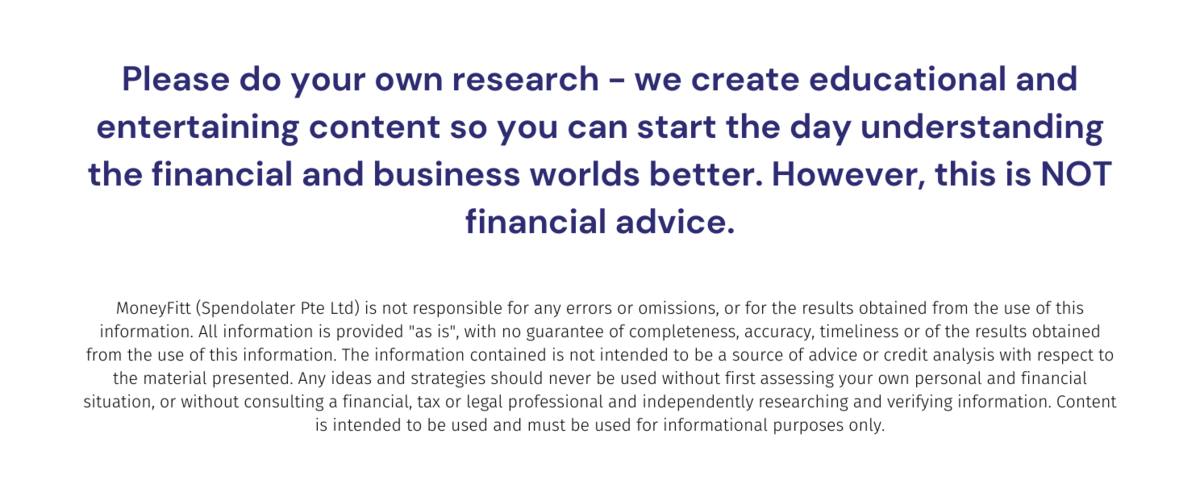
Happy Friday!
This weekend, we also celebrate Hari Raya Pausa here in Singapore. We congratulate all those who have made it to the end of the month of fasting and wish you a wonderful celebration.
It can be overwhelming to the uninitiated, especially to all our non-Muslim friends. To those, we present our helpful guide on understanding Hari Raya Puasa!
📝 Focus
Tesla Tanks!
📊 In the Markets
Soft landing, ASML, TSMC
📖 MoneyFitt Explains
🎓️ Gross and Net Profit Margins

📝 Focus
Tesla Tanks!
Not a battery-powered tank but a 9.8% drop in Tesla's share price on Thursday, wiping off $55bn from the market capitalisation (share price X number of shares) of Elon Musk's Tesla the same day that his SpaceX Starship was launching (watch it blow up here.) The first quarter results that led to the collapse were already widely expected to show a decline in profit from a year ago due to lower profit margins on higher sales spurred by aggressive price cuts. But the scale of the profit and margin drop was worse than Wall Street's highly-paid analysts were expecting -- earnings per share fell 21% despite a 24% jump in revenue, leading margins to just 19.3%, 1/3rd down from the same period last year and the lowest in two years.
“We’re the only ones making cars that technically could sell for zero profits now and yield tremendous profits in future through autonomy... I'm not sure how many people will appreciate the profundity of what I've just said, but it is extremely significant.”
Tesla CEO Elon Musk, referring to selling self-driving cars which could double up as robo-taxis (and Wall Street's lack of profundity)
..... ▷ Traders were also disturbed by the CEO’s willingness to sacrifice margins and profits to drive up demand and maintain (or grow) market share. At 18.3%, its auto margins fell way short of the 23.2% analysts were expecting and even missed the 20+% forecast by the company as it launched the price war in January. Just before the results, Tesla slashed prices for the sixth time this year, with Musk suggesting more such cuts ahead, expectations for which may keep interested buyers sidelined for a lot longer (and which led to share price weakness across other automakers globally, from GM to Lucid to Renault.)

The direction Tesla's margins are going - Image credit: Tenor
..... ▷ “We've taken the view that pushing for higher volumes and a larger fleet is the right choice here”, he said, referring to Teslas sold as a “fleet.” Cars that Tesla sells may be able to double up as robotaxis in the future, if they have the Full Self Driving (FSD) software installed and if Tesla launches its own ride-hailing network. (The robotaxi that Musk plans for 2024 will be a different vehicle designed specifically for autonomous driving and will not have a steering wheel or pedals.)
..... ▷ One UK study also showed that Tesla cars lose their second hand value after new car prices cut faster than its rivals do. Auto industry pricing agency CAP HPI forecast that the value of a new Model 3 bought in January 2023 would fall by 46% by January 2024, compared to a 35% drop for the electric Polestar 2 (and a 4% drop in the 12 months to September 2022. A steeper depreciation potentially makes Teslas more expensive in lease financing than rivals since motorists have to finance the value of cars, and lose over the leasing period, i.e. the more value a car is expected to lose, the higher monthly payments typically are. This totally runs against Musk's own statement as he initiated the EV price war - “The desire for people to own a Tesla is extremely high. The limiting factor is their ability to pay for a Tesla.”
..... ▷ Meanwhile, French automaker Renault, which is planning to list its Ampere EV unit in Paris this year at a potential valuation of $11bn, warned that cutting EV prices would “kill” the residual value of the cars, driving up customer monthly lease payments. “If it results, short term, in slightly lower volume, so be it.”

If you are enjoying The MoneyFitt Morning and would like to continue learning what's important in investing & business, please subscribe!

📊 In the Markets
US and European stocks were a little weaker on Thursday as first quarter earnings continued to roll in, with a few more notable misses leading to plunging prices, including Tesla, data storage company Seagate and telco AT&T. This followed declines in most of Europe and a mixed day in Asia. Chip equipment maker and Europe's largest tech company ASML seemed to stabilise after a rough few days. (See below.)
..... ▷ But US Treasuries (bonds issued and backed by the US government) rallied on unemployment figures that came in slightly higher than expected, suggesting that inflationary pressures were easing, with the chances of a weaker economy, or even a recession, slightly higher. That would mean that interest rates from the Fed were more likely to peak and come down slightly sooner, and lower interest rates mean higher bond prices (they always go in opposite directions.) US Dollar, which reflects, among many other things, expected interest rate differentials with major trading partners, weakened a little.
“The 'soft landing,' of course, is what we're aiming for... In this environment, I do think we're going to have very slow growth - I think growth will be well below 1%”
Loretta Mester, President of the Federal Reserve Bank of Cleveland and a Wharton finance professor
..... ▷ New applications for state unemployment benefits in the US (quite a reliable figure compared to many of the survey-based data that comes in) rose a bit more than expected in the week to April 15, in another sign (on top of slumping retail sales and manufacturing activity, ongoing housing recession) that the rapid hikes interest rates over the last 13 months to combat runaway inflation were finally having an effect in slowing the economy. More recently, banks, losing deposits and spooked by other bank failures, were being stingier with their lending, making it harder for households and small businesses to access credit. It's just a single week's data, but important as the labour market in the US remained very strong even as growth and inflation data started to cool, standing out as a risk to those slower-rising prices.
“Overall demand still exceeds our capacity for this year and we currently have an (order) backlog of over 38.9 billion euros"
ASML CEO Peter Wennink
..... ▷ Europe's biggest tech firm ASML beat first-quarter earnings forecasts on continued strong demand for its chip making equipment, with net profits up 180% on a revenue pickup of 91% (expanding profit margins 🎓.) It did note caution from both "certain segments of logic" as well as memory, with Samsung belatedly joining rivals SK Hynix and Micron in cutting production and expansion plans. (These are the two largest categories of computer chips.) The Dutch company has a monopoly on extreme ultraviolet lithography, or EUV, a crucial technology needed for logic and increasingly memory chips with transistors 7 nm apart or below, and in fact has struggled to meet demand as customers such as TSMC, Samsung and Intel continue to spend billions on the expansion that is absolutely necessary to compete with one another. It's like selling guns and bullets to all sides.
..... ▷ Meanwhile, ASML's largest customer TSMC, which makes chips for the likes of Apple, Nvidia and AMD, warned that a weaker-than-expected recovery in China hit demand for its semiconductors and cut its forecast for the non-memory semiconductor market this year to a mid-single-digit percentage decline.

📖 MoneyFitt Explains
🎓️ Gross and Net Profit Margins
The gross profit margin is the percentage of revenue that remains after accounting for the cost of goods sold (COGS), while the net margin is the percentage of revenue that remains after accounting for all expenses, including COGS, operating expenses, taxes, and interest.
Gross margin is a measure of how efficiently a company manages its production costs.
Net margin is a measure of how efficiently a company manages all its expenses, including production, operating, and financial costs.
A higher gross margin means a company is better at controlling production costs, while a higher net margin means a company is better at controlling all expenses. Both gross and net margins are important indicators of a company's financial health and are closely watched by investors and analysts.





